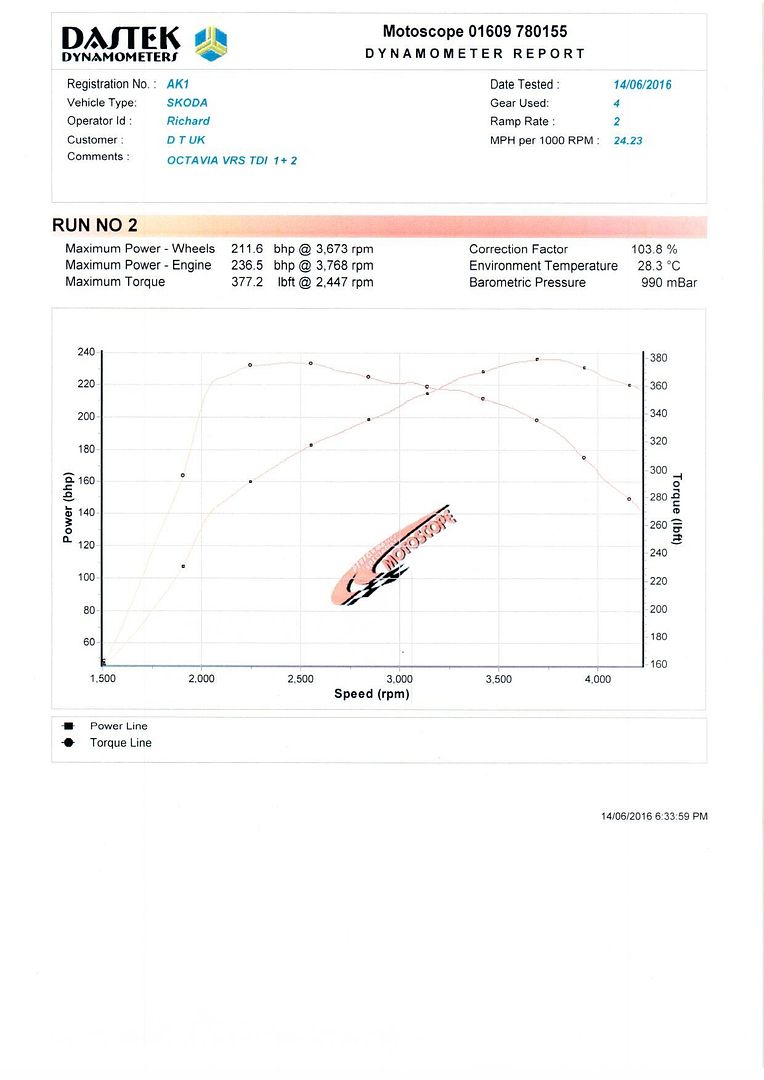Okay...... ready for the dyno results?
We did 6 runs in total. The first two runs were in stock, the next two in p2 and the final two in p2+1. I didn't have the time to test p1 and p3, but at the end of the day I didn't really want to after the results I got.
The first diagram below is the comparison between the stock run (dotted lines) and the P2 (continuous lines):
Well, well. A few remarks:
- The stock engine was measured at 191.1PS / 389.6Nm. That's about 4% higher than SEAT official figures, and no surprise really since VAG group tend to understate those figures. Two consecutive runs gave the exact same figures and curves, so all was well with the dyno too
- The engine does improve above the 3,500RPM mark, reaching a top figure of 212.2PS at about 4,100RPM. This finding is confirmed with the feel on the road - the engine revs faster and more freely at the top range, which helps in 0-60 stats. The same applies to the torque - above 3,500RPM the torque remains more or less level and delays to fade out (actually, the correct way to put it would be that the torque remains level and, as a result, the HP increases)
- Now for the negatives: At around 1,700RPM there is a huge spike which is followed by an immediate dip, which stabilizes again at around 2,400RPM. We have confirmed this in both runs (and it also happens in the p2+1 as we will see later). The dyno guys were asking me if I could feel the engine bogging down in that range; they were really surprised to see that. Of course this is consistent with problems such as coil lights and limp modes when the engine is pressed at low RPMs. It appears that the torque request is excessive, and the main ECU doesn't agree with something. It could be a torque limiter, a smoke limiter, who knows, but it's clear that the ECU interferes and cuts the fuel preventing the torque to reach the requested value. Perhaps there is a chance that this happens only in full throttle, and in 50% throttle (for example) the engine may feel more flexible and responsive. However this is the (negative) picture of the dyno result.
- As a result of the above, there is a torque peak figure of 422.7Nm @ 2,000RPM, but this is deceiving, since it only exists for a brief moment. In fact, the torque all the way until 3,500RPM is actually BELOW the stock engine. The exact same thing is true for the horsepower as well. Up until 3,500RPM the power output is actually lower than stock. I would say a more representative figure for the torque is around 375Nm (about 15Nm down).
- All in all, considering the promised power / torque benefits (240/500), the tuning box in this setting falls way, way short of that. Quite disappointing.
Moving on to p2+1:
- Disclaimer: I think that the engine didn't have the time to properly "adjust" to the change of program, so some things may appear slightly worse (than if I'd let the engine run in this setting for a couple of weeks). In any case, I think it's representative
- As you can see the sudden spike is again very, very there. The torque is disappointingly low throughout the range and you do get some power higher up but nor really that much. The top horsepower measured was 204.3PS @ 4,200RPM, a meager increase of 14PS over stock. Again, the engine's output up until 3,750RPM is lower than stock.
OK... That's what the dyno said, and I believe it's quite clear. All 6 runs were pretty consistent, i.e. the 1st run on p2 was identical to the 2nd run on p2, etc. This box didn't deliver the promised gains (I mean, not by a long way) and it actually made the car worse until 3,500 - 3,750. A very pronounced spike and dip is noticed in the 1750 - 2,500 range which may be the reason for all those limp home modes and coil lights.
Hope the above helps.









